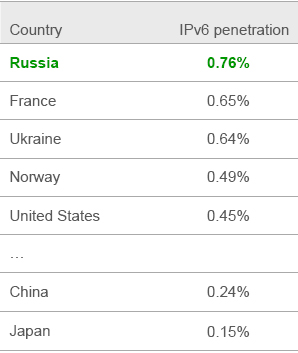The practicality of IPv6
From Computing and Software Wiki
IPv6 is an Internet Layer protocol that was created to succeed the currently-used IPv4 (which will eventually need replacing). The official specification of IPv6 was released in December of 1998 [ 1 ], and after a decade it still has not become a fully-adopted Internet Protocol. While recent efforts have increased IPv6's overall internet-wide penetration [ 2 ], IPv4 is still the dominant protocol by a vast margin. There are several issues concerning the feasibility of the overall adoption if IPv6, resulting in some doubting the very need for a completely new protocol. There is much more to the protocol than simply adding or replacing a certain piece of hardware or software, and this has lead to the situation where potential future adopters are reluctant to use the protocol, unable to see how IPv6's advantages offset its high costs; this is especially relevant for potential adopters who do not see themselves requiring more IP addresses than they already have.
How to reference: [ 1 ]
Contents |
IPv4 Address Exhaustion
The concept of IPv4 address exhaustion is quite simple: eventually, the internet will run out of unallocated IPv4 addresses. While the exact day for IPv4 exhaustion has not been globally established, most reports indicate that it will happen in the year 2011. The Asia-Pacific Network Information Centre believes the date of IANA (Internet Assigned Numbers Authority) address exhaustion to be June 16th 2001[ 3 ] while the Organisation for Economic Cooperation and Development (OECD) believes this date will land in early 2011 [ 4 ].
There are several other factors contributing to the exhausting. The most significant one is also the most recent; internet-ready cellular phones can also play a significant role, especially considering the fact that these devices are common. Ununsed IPv4 addresses are also becoming more difficult to reclaim due to the advent of broadband internet; an internet method that, unlike dialup, is typically always on. Also, the potential for inefficient address use during IPv4's early days may also have caused exhaustion to occur sooner.
IPv6 Adoption
There are many issues and intricacies surrounding the adoption of IPv6. While the numbers may be considered underwhelming, the IPv6 adoption statistics may provide a perspective of what countries or platforms could be considered the most progressive in this regard.
Worldwide Breakdown
According to a Google study[ 5 ], no more than 1% of the internet traffic from 'any' country worldwide uses IPv6. Russia has the most IPv6 traffic with .76%. China, at .24%, would be argued to have more overall IPv6 volume than any other country, but in proportion its IPv6 adoption rate is still significantly smaller than some other countries.
Platform-wide Breakdown
Struggles with Adoption
Main article, cost, etc
Usage Statistics
From that main article
Internet Readiness
Talk about 6bone, Beijing, US Gov't, etc
Scrutiny and Criticism of the Protocol
That crazy guy.
References
- Deering, S. and Hinden, R. RFC 2460, Internet Protocol, Version 6 (IPv6). The Internet Society, 1998.
- Das, Kaushik. IPv6 and the 2008 Beijing Olympics. http://www.ipv6.com/articles/general/IPv6-Olympics-2008.htm
- Huston, Geoff. IPv4 Address Report. http://www.potaroo.net/tools/ipv4/index.html
- Harris, Mark. Waiting for the Internet Meltdown. The Sunday Times, July 6, 2008. http://technology.timesonline.co.uk/tol/news/tech_and_web/the_web/article4271879.ece
- Gunderson, S.H. Global IPv6 Statistics. Google. http://rosie.ripe.net/ripe/meetings/ripe-57/presentations/uploads/Thursday/Plenary%2014:00/upl/Colitti-Global_IPv6_statistics_-_Measuring_the_current_state_of_IPv6_for_ordinary_users_.7gzD.pdf
External Links
(External Links)
See Also
(Internal Links)
The Future of the Internet: IPv6

![Figure 2: Worldwide IPv6 Demographics[5]](/images/6/6a/IPv6Chart.jpg)
